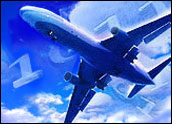
Customer satisfaction with the airline industry took a dip in J.D. Power and Associates’ 2012 North America Airline Satisfaction study after two consecutive years of improvement.
The drop was not a large one; overall, passenger satisfaction dropped to 681 index points on a 1,000-point scale. In 2011, the score was 683.
Even though satisfaction declined, it was still higher than levels in 2008, when passengers were feeling particularly sour towards carriers, said Jessica McGregor, senior manager of global travel and hospitality for J.D. Power.
Still, the index score points to a seemingly unbridgeable gap between consumers’ expectations of airlines and what airlines are in fact able to deliver.
“The takeaway from this year’s survey is that airlines are clearly caught between trying to satisfy customers and still needing to be profitable,” McGregor told CRM Buyer.
“Passengers have certain expectations, but they are not willing to pay higher plane fares to get them. So that presents the airlines with a conundrum,” she said.
Airlines are delivering on the basics, “but passengers expect more, and that is where the challenge lies,” noted McGregor.
It’s not universally accepted that the airlines are even trying to meet customers half way to fill this gap, however.
“It seems to be a race of who can anger customers the most,” John Tschohl, author of the book Achieving Excellence Through Customer Service and president of the Service Quality Institute, told CRM Buyer.
“Each day, we hear of an airline doing something that’s going to turn people off. Just this week, United, for example, said it will raise the price of a second checked bag to (US)$100.”
Who Ranks Where
Alaska Airlines ranked highest in the survey’s traditional network carrier segment, followed by Air Canada and then Delta Air Lines.
JetBlue Airways ranked highest among low-cost carriers, followed by Southwest Airlines.
A Tale of Two Types
There’s a growing gap between how passengers feel about low-cost airlines and traditional airlines, the survey indicated. Low-cost airlines — a group that includes Southwest and JetBlue — rank at the top of the customer satisfaction index, while traditional carriers are still struggling.
Satisfaction with low-cost carriers improved for the third consecutive year, rising three index points to 754 over 2011’s score. Traditional carriers, meanwhile, declined four points to 647.
Lower prices were one driver behind the higher scores, McGregor said — but they weren’t the entire story.
“Low-cost carriers also scored higher on flight services and flight crew. Price, in short, is not the only differentiator,” she pointed out.
Piling on the Fees
Certainly that makes sense when one looks at the reasons behinds customers’ irritation with carriers. Fees — seemingly ever-proliferating fees — top the list, especially when they are applied on services that were once free.
“Passengers hate the unbundling of fees,” McGregor said.
In particular, checked baggage fees are a sore point; the survey found that customer satisfaction averaged points lower among passengers who paid to check bags.
It is little coincidence that the carriers that ranked the highest — JetBlue Airways and Southwest Airlines — do not charge passengers to check the first bag, McGregor said. Then there is Air Canada, a traditional network carrier, which performed well in the survey. It too does not charge for the first bag.
More than 70 percent of passenger satisfaction, though, is driven by nonfinancial issues, such as the carrier’s processes and people. Customers really like mobile check-in, for example; the survey found that satisfaction with the check-in process was highest when passengers could use their mobile devices.
Conversely, carriers’ rigid processes for customer service issues tend to drive customers crazy, Tschohl said.
“The airlines have lost the human touch,” he maintained. “It took Spirit Airlines, for example, getting all kinds of negative publicity to refund a dying vet the price of his ticket because he was too sick to fly.”




















































